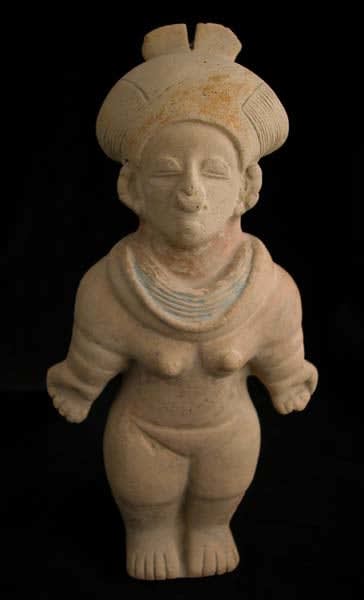Jama Coaque Terracotta Sculpture of a Standing Woman, 200 BCE - 600 CE
Terracotta
5 x 10.125
PF.2360
Further images
The Pre-Columbian cultures of Ecuador are among the oldest in South America and among the first to master the art of pottery. Although we know little about the peoples themselves...
The Pre-Columbian cultures of Ecuador are among the oldest in South America and among the first to master the art of pottery. Although we know little about the peoples themselves or their traditions, historians have been able to piece together a picture of life in Ancient Ecuador thanks in part to the art and artifacts left behind. The culture of Valdivia created some of the oldest known works of art in the Americas. Situated along the coastal strip of Ecuador, the Valdivians established a thriving society that flourished for around two thousand years (from approximately 3500 to 1500 B.C.). Today they are famed for their small fertility figures, believed to be the earliest representational works of art in the Americas, first carved from stone, later formed from terracotta.
Hundreds of years later after the Valdivians disappear from the archaeological record appears another culture to which the name Chorrera has been attached (lasting from circa 1100-300 B.C.). Little is known about this culture; however, it is significant for its widespread geographical reach. As such, their artistic style greatly influenced those diverse cultures that began to emerge in the final centuries of the Chorrera period, a time historians have labeled the Period of Regional Development.
Among the most prominent cultures that flourished in the wake of the Chorrera are the cultures of Bahia, Jama Coaque, and La Tolita. Around 200 B.C., the Bahia developed along the coastal strip in the modern province of Manabi, lasting until approximately 600 A.D. Their earliest terracotta works were greatly indebted to the Chorrera; however, over the years a distinctive style emerged characterized by large figures adorned with detailed dress and body ornamentation.
Bahia is closely related to the culture known as Jama Coaque, sharing a similar style and common chronology. They inhabited the forested hills lining the coast of northern Manabi. The city of San Isidro was their cultural and ceremonial center, featuring several temples surmounting a large pyramid. Similar to the Bahia, Jama Coaque is known for its large terracotta figures, typically sculptured in a variety actions and poses. Ceremonial figures are also well-know, typically formed with the arms held along their sides, palms facing outwards.
The pottery traditions in Ecuador are some of the oldest in the New World, with discoveries of fired ceramics dating to as early as 3000 B.C., evidencing a long pottery sequence in this highly innovative culture. This Manabi female figure from the Jama Coaque period demonstrates the Ecuadorian craftsmen's refined skill at manipulating the medium and his creative ability to express heightened spirituality and power. A standing female figure faces us with arms outstretched, palms open, her womanly attributes accentuated. A dynamic, crested turban with incised decorations adorns her head, while a nose ornament and heavy-lidded eyes give her facial expression a truly mystical quality. Whispers of orange and green paint around her patterned collar, neck and turban hint at her once-colorful image, serving now to enhance her mysterious nature. To behold this spiritual image of Pre-Columbian art is to imagine her outstretched arms wrapping themselves around us in a captivating embrace of ancient, divine emotion and wisdom.
Hundreds of years later after the Valdivians disappear from the archaeological record appears another culture to which the name Chorrera has been attached (lasting from circa 1100-300 B.C.). Little is known about this culture; however, it is significant for its widespread geographical reach. As such, their artistic style greatly influenced those diverse cultures that began to emerge in the final centuries of the Chorrera period, a time historians have labeled the Period of Regional Development.
Among the most prominent cultures that flourished in the wake of the Chorrera are the cultures of Bahia, Jama Coaque, and La Tolita. Around 200 B.C., the Bahia developed along the coastal strip in the modern province of Manabi, lasting until approximately 600 A.D. Their earliest terracotta works were greatly indebted to the Chorrera; however, over the years a distinctive style emerged characterized by large figures adorned with detailed dress and body ornamentation.
Bahia is closely related to the culture known as Jama Coaque, sharing a similar style and common chronology. They inhabited the forested hills lining the coast of northern Manabi. The city of San Isidro was their cultural and ceremonial center, featuring several temples surmounting a large pyramid. Similar to the Bahia, Jama Coaque is known for its large terracotta figures, typically sculptured in a variety actions and poses. Ceremonial figures are also well-know, typically formed with the arms held along their sides, palms facing outwards.
The pottery traditions in Ecuador are some of the oldest in the New World, with discoveries of fired ceramics dating to as early as 3000 B.C., evidencing a long pottery sequence in this highly innovative culture. This Manabi female figure from the Jama Coaque period demonstrates the Ecuadorian craftsmen's refined skill at manipulating the medium and his creative ability to express heightened spirituality and power. A standing female figure faces us with arms outstretched, palms open, her womanly attributes accentuated. A dynamic, crested turban with incised decorations adorns her head, while a nose ornament and heavy-lidded eyes give her facial expression a truly mystical quality. Whispers of orange and green paint around her patterned collar, neck and turban hint at her once-colorful image, serving now to enhance her mysterious nature. To behold this spiritual image of Pre-Columbian art is to imagine her outstretched arms wrapping themselves around us in a captivating embrace of ancient, divine emotion and wisdom.







